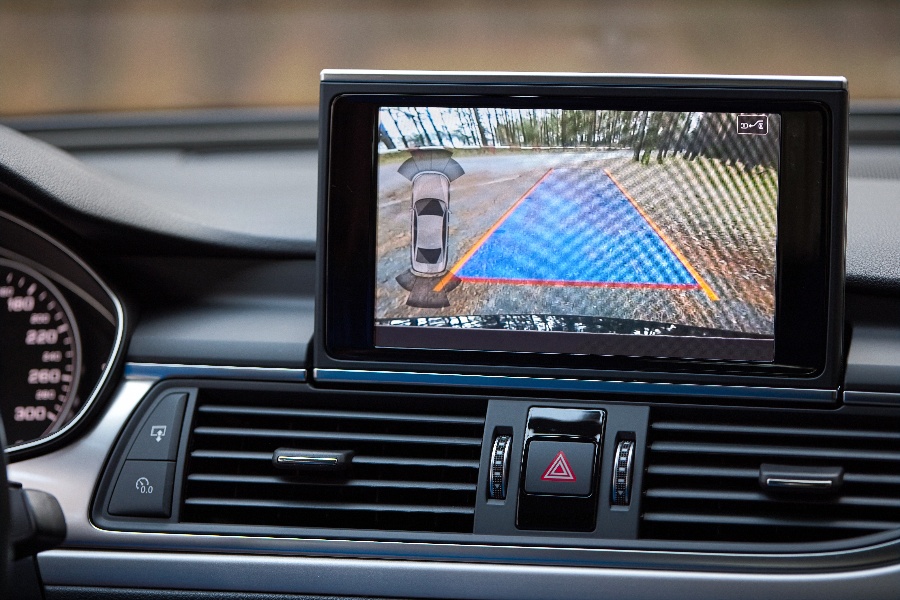
Approximately one in four accidents (25%) involves backing. This statistic is even more concerning given that the typical driver drives in reverse for less than a mile every year. The good news is that recent advances in automotive technology have made it possible to install both rear cross-traffic warning systems and backup cameras which can help drivers more safely maneuver their vehicles while reversing.
This guide will provide an overview of these two technologies, their features, and the importance of using them to reduce the risk of accidents while driving in reverse.
What is Rear Cross Traffic Warning (RCTW)?
Rear Cross Traffic Warning (RCTW) is an advanced driver assistance system that uses sensors to detect approaching vehicles and objects when a driver is backing up their vehicle. It alerts the driver to any potential hazards before they emerge from behind the vehicle, giving them extra time to react and avoid a collision.
RCTW works by using a combination of radar, ultrasonic, laser, or optical sensors located on both sides of the vehicle. These sensors scan the area surrounding the car and detect any moving objects in their path. When something approaches within a certain safety distance, the system will alert the driver with an audible warning sound and/or visual indicator on either the dashboard display or rearview mirror.
The RCTW system also acknowledges areas that are too small for a conventional backup camera to see, such as tight corners or narrow driveways. This makes it much easier for drivers to back up in tight spaces without fear of hitting something unseen.
Additionally, some vehicles equipped with RCTW also incorporate multi-angle camera systems that can provide rearward images from three different angles: normal view, wide-angle view, and top-down view. This allows drivers to have more information about their surroundings when reversing and helps reduce blind spots even further.
What is a Backup Camera?
A backup camera system is an advanced driver assistance system designed to provide drivers with an extra layer of safety when reversing their vehicle. The system consists of a rearview camera mounted at the back of the car, as well as a display in the front cockpit that shows what's behind the car in real time.
Backup cameras provide drivers with a wider field of view than traditional mirrors and can help detect any potential obstacles or hazards behind the vehicle before they become visible. Additionally, some models are equipped with sensors that can measure distances between objects and alert drivers if they get too close to them while backing up. This helps reduce blind spots and eliminates most chances of rear-end collisions.
Overall, backup cameras are an essential feature for any modern vehicle and can help keep drivers safe on the road. They provide drivers with more visibility when reversing and give them extra time to react if any obstacles or hazards appear in their path.
Types of Backup Cameras
Backup cameras come in a variety of different types, depending on the make and model of the vehicle.
Traditional backup cameras are usually mounted at the back of the car and provide drivers with a wide-angle view behind them. These systems can be wired directly into the vehicle's electrical system or powered by batteries for easy installation.
Wireless backup cameras are another popular option and provide drivers with a clear image of what's behind them without complicated wiring. These systems operate by transferring the camera's signal wirelessly to a receiver in the front cockpit, making them easy to install and use.
Multi-angle backup cameras are also available and provide drivers with up to three different views of their surroundings. These systems can be used to help drivers see around tight corners or narrow driveways and are especially useful in vehicles with limited space.
How Do Both Systems Work Together?
Rear Cross Traffic Warning and Backup Cameras are designed to work together, with each system providing an extra layer of protection when backing up.
For example, the RCTW system can detect approaching vehicles or objects from the sides of the car while the backup camera provides a full view of what's behind it. By combining these two systems, drivers have increased visibility both in front and around their vehicle which helps them avoid any potential dangers on the road.
Overall, Rear Cross Traffic Warning and Backup Cameras offer drivers an extra layer of protection when reversing or driving in tight spaces where visibility is limited. They provide drivers with more information about their surroundings and help reduce blind spots that could potentially lead to accidents. By combining both systems, drivers can have peace of mind knowing that they are better prepared for any potential hazards on the road.
How to Choose the Right Rear Cross Traffic Warning or Backup Camera System for Your Fleet
When choosing a Rear Cross Traffic Warning or Backup Camera system for your fleet, there are several factors to consider.
First, it's important to think about the type of vehicle you'll be using and how that will affect which system is best suited for your needs. For example, if you have larger vehicles that need to be able to maneuver in tight spaces, you may want to consider a multi-angle backup camera system that can provide multiple views of your surroundings.
Additionally, it's important to think about the size and capabilities of the display in your cockpit. Larger displays typically provide better visibility and help drivers see more behind their vehicles.
It is important to consider the installation process. Some systems require complicated wiring while others are wireless and can be installed quickly and easily.
You should compare the different features and capabilities of each system. Many backup cameras come with additional features such as parking sensors, night vision, and even object detection which can help make reversing easier.
Finally, it's important to consider the cost of each system. If your budget is limited, you may want to opt for a traditional wired system instead of a wireless one. While these systems may not have as many features, they can still provide you with the visibility and safety that your fleet needs.
Ultimately, Rear Cross Traffic Warning and Backup Cameras offer drivers an extra layer of protection when reversing or driving in tight spaces where visibility is limited. They provide drivers with more information about their surroundings and help reduce blind spots that could potentially lead to accidents. By combining both systems, drivers can have peace of mind knowing that they are better prepared for any potential hazards on the road.
Wilmar Inc. is your number one fleet safety and management solution. Contact us today for more information about our comprehensive fleet safety solutions. We will help you choose the best Rear Cross Traffic Warning and Backup Camera system for your needs.
We're always ready to assist you on the road to safer driving!








